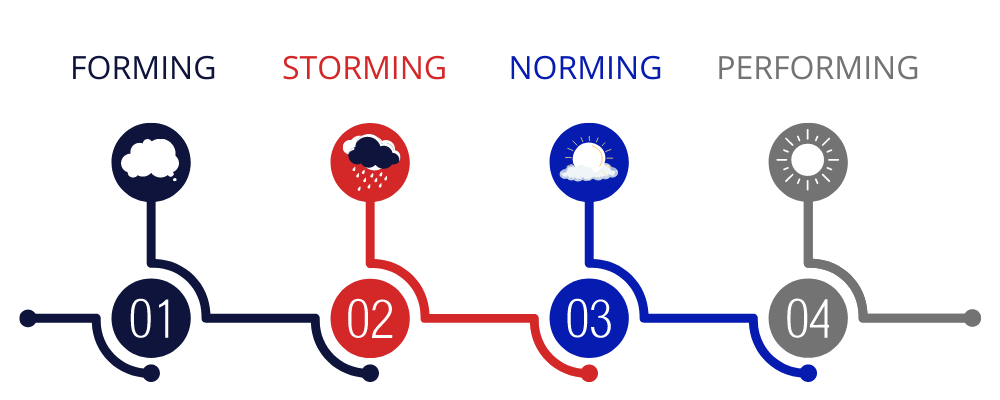Team building is essential for any business. It helps to create a sense of community and encourages productivity. Not only that, but team building is guaranteed fun and promotes the power of play!
Team building can be defined as “a process that helps people to work better together.”
It is a way of fostering communication and collaboration within a team. Team building can help to improve performance, morale, and motivation within a team. Its a win win win!
There are many different types of team building activities, each with its own benefits however with an increasing workload and a greater need for connection than ever before it can be an overwhelming task trying to choose the best option for your team. Fortunately, you don’t need to be a rocket scientist to figure it out! Team-building can be tailored to suit your team’s individual needs – the key component being understanding the current stage that your team is in and where their underlying needs lie.
Let’s dig a bit deeper- here are our top tips to identifying the right team building program for your team.

Step 1: What stage is your team at?
Bruce Tuckerman’s theory of team development is a useful tool for understanding the stages that teams go through as they develop and grow. According to his model, there are four stages: forming, storming, norming and performing. Each stage has its own characteristics which can be used to identify where your team is at in their overall development process. Knowing this can help you choose the right team building program for your team and ensure that it meets their needs.
At each stage of the FSNP (Forming, Storming, Norming, and Performing) model, different human skills are developed.
In the ‘Forming’ stage, teams get to know each other and build relationships. Team members focus on getting to know what their role is within the team and how they can fit in. This stage requires strong communication skills and interpersonal skills to foster a positive environment. Team members need to be open-minded and willing to learn about each other. Team activities at this stage should be light-hearted and focus only on fun and team bonding.
The ‘Storming’ stage is all about conflict resolution as team members work together to solve problems. Team members need to be patient and tolerant of different opinions in order to reach an agreement. They must possess exceptional problem-solving capabilities in order to move forward.
In the ‘Norming’ stage, teams become unified as they start working together more closely. They develop norms and expectations for themselves and for each other. At the ‘Norming’ stage, teams need to have strong teamwork and communication skills. Team members must be able to collaborate effectively and work together towards a common goal. They need to be able to recognize each other’s strengths and weaknesses, and use them in order to come up with creative solutions.
Finally, when teams reach the ‘Performing’ stage, they are able to work together efficiently with minimal guidance from leaders or managers. Team members should have strong leadership qualities as well as cooperative mindsets in order to ensure that tasks are completed successfully within agreed timelines. Additionally, they should have good decision-making abilities so that they can make well-informed decisions quickly under pressure when needed.

Step two: Assessing your team.
Now that you know what stage your team is at you can start to understand and break down what human skills to focus on. It may not be obvious what they lack, so it’s up to you as the leader to identify and nurture those areas. Although this can seem like a daunting task, there are numerous tools and resources available to help detect human skills gaps within a team environment so you can address them accordingly.
One way a leader can assess human skills gaps is through the use of questionnaires and surveys. Team members can be asked to answer questions about their individual strengths, weaknesses, and areas for improvement as well as those of the team. These surveys can provide valuable insight into the team’s dynamics and areas where additional development may be needed. It may also be beneficial to conduct one-on-one interviews with team members to get a better understanding of their views, experiences and opinions. Another way leaders can assess teams human skills gaps is through observation. Team members can be observed while they are working together in order to identify any areas where they could improve.

Step three: Setting goals.
Now you know what stage your team is at and what skills you want to focus on, you can turn these into tangible and robust goals. Your goals should be SMART, meaning they must be specific, measurable, achievable, realistic and time-bound.
Whilst your goals should focus on developing the team, do not underestimate the power of including goals that enhance a teams strengths. Choosing goals that focus on the team’s strengths can help to improve team alignment. When everyone is working together and using their individual talents, the team is more likely to succeed. When a team is successful, they are stronger and more agile.

Step four: Finding a provider.
You now have a wealth of valuable knowledge and data to take to your chosen team building company. It is so important in the planning stage that your provider understands what your key outcomes for the team building exercises are, so they can recommend and structure a program to achieve these.
When selecting a team building supplier, one should look for a provider that has the experience and expertise to carry out the program in accordance with your goals. Team building suppliers should have a deep understanding of the different stages of team development and be able to customise programs to suit individual teams.
It is important to ensure that the team building provider understands your organisation’s culture, vision and values, as this will ensure they can design a program that aligns with both your smart objectives and your companies DNA.
A quality team building provider will then be able to provide a list of programs tailored to your teams stage of development, skills gaps and strengths.
It’s important to note here that each team building program will be made up of a number of activities that can highlight a particular skill. For example, you may have chosen a charity team building program as your over-arching goal is to improve employee engagement. Each activity that makes up the program can then focus on a different attribute to improved employee engagement.

Step five: choosing activities.
A planning session with your facilitator will assist you in coming up with activities that concentrate on key areas of interest. Each activity within the team building program should directly relate back to one of your smart objectives. Perhaps you want to improve communication, then including an activity that tests verbal and nonverbal communication can help teams reflect on their own strengths and weaknesses.
It is important to ensure that the activities chosen are suitable for the skill sets and abilities of your whole team. The best team building programs will be tailored to each individual team’s needs, capabilities and development goals.
Team building events are important financial and time investments for any company or group. That is why you should strive to ensure that your team derives maximum value and benefit from the occasion. It may seem like a lot to digest but by taking the steps to strategically choosing a team building program that really suits your team’s needs, you will be sure to increase team morale, productivity and efficiency.
Finally, remember that team building is an ongoing process, not a one-time event. You should keep reinforcing the learning obtained from your team building event and ensure that everyone stays on track with the company’s goals so that your hard effort pays off. Investing in team building activities on a regular basis will pay for itself in the long run with a more productive, cohesive team, but only if it’s done right.





Recent Comments